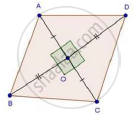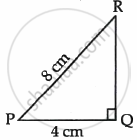Advertisements
Advertisements
प्रश्न
Each side of a rhombus is 10 cm. If one of its diagonals is 16 cm find the length of the other diagonal.
उत्तर

We have,
ABCD is a rhombus with side 10 cm and diagonal BD = 16 cm
We know that diagonals of a rhombus bisect each other at 90°
∴ BO = OD = 8 cm
In ΔAOB, by pythagoras theorem
AO2 + BO2 = AB2
⇒ AO2 + 82 = 102
⇒ AO2 = 100 − 64 = 36
⇒ AO = `sqrt36` = 6 cm [By above property]
Hence, AC = 6 + 6 = 12 cm
APPEARS IN
संबंधित प्रश्न
A triangle has sides 5 cm, 12 cm and 13 cm. Find the length to one decimal place, of the perpendicular from the opposite vertex to the side whose length is 13 cm.
ABCD is a square. F is the mid-point of AB. BE is one third of BC. If the area of ΔFBE = 108 cm2, find the length of AC.
In an isosceles triangle ABC, if AB = AC = 13 cm and the altitude from A on BC is 5 cm, find BC.
In an acute-angled triangle, express a median in terms of its sides.
In right-angled triangle ABC in which ∠C = 90°, if D is the mid-point of BC, prove that AB2 = 4AD2 − 3AC2.
In an equilateral ΔABC, AD ⊥ BC, prove that AD2 = 3BD2.
Determine whether the triangle having sides (a − 1) cm, 2`sqrta` cm and (a + 1) cm is a right-angled
triangle.
ΔABC~ΔDEF such that ar(ΔABC) = 64 cm2 and ar(ΔDEF) = `169cm^2`. If BC = 4cm, find EF.
A man goes 12m due south and then 35m due west. How far is he from the starting point.
In the given figure, ΔPQR is a right triangle right angled at Q. If PQ = 4 cm and PR = 8 cm, then P is ______.

